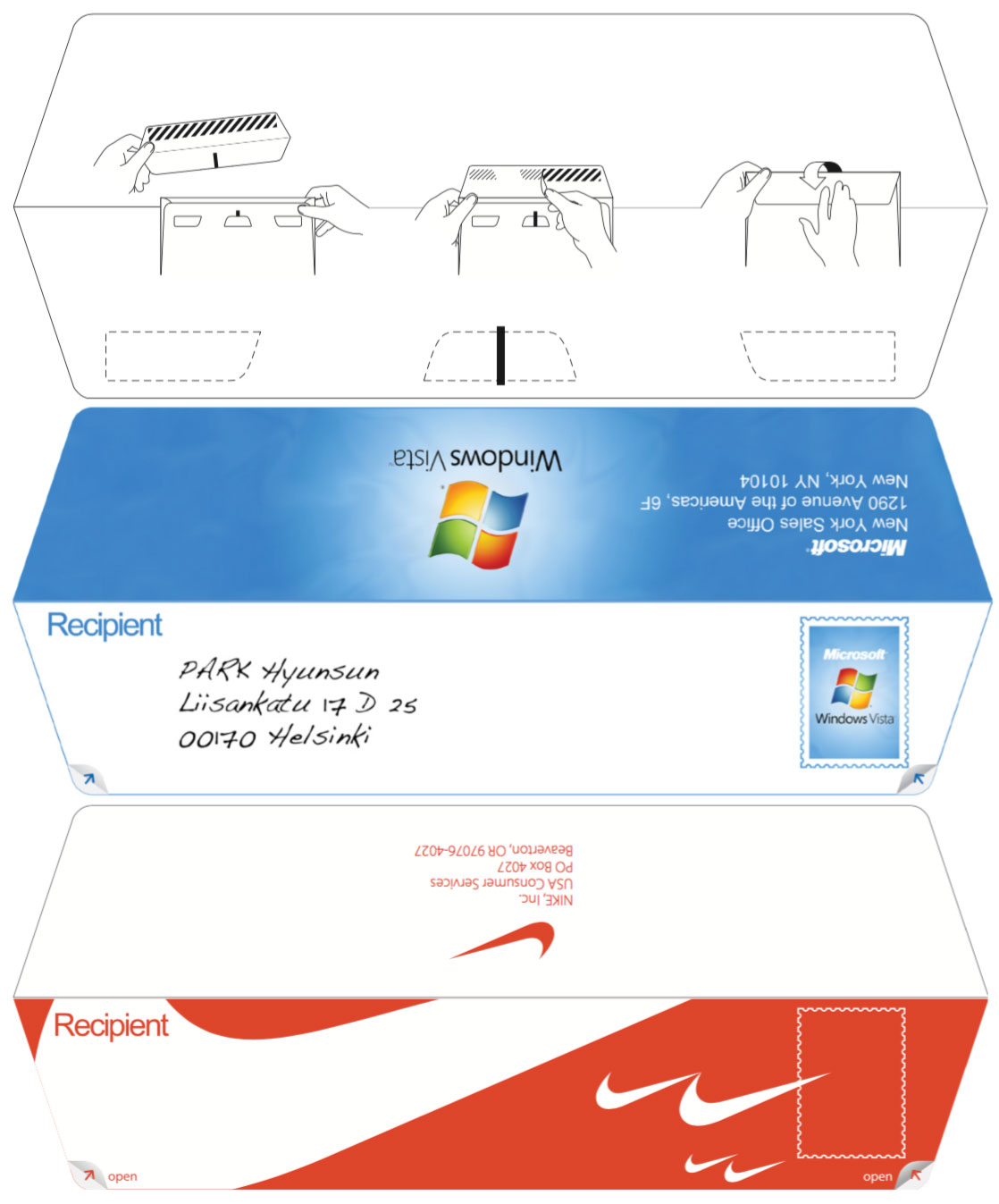
Posti, the Finland Post, asked the University of Art and Design Helsinki1 to design Long-Life Envelopes that can be used more than 20 times. As a newly privatised postal service company, Posti wanted to be equipped with a competitive edge to be a global logistics service provider. They regarded RFID2 technology as a potential core competence that will help them grow globally, given that RFID chips enables real-time-trace. The price of RFID chip was, however, several times more than that of an envelope, which made Posti come and ask for the reusable envelope design concept.

Eight students with all different nationalities conducted the research phase as a team. The team aimed to avoid creating a whole new solution that won’t work with current infrastructure, and therefore visited number of places: RFID lab, paper factory, envelope factory, the sorting center of Posti and an insurance company that uses millions of envelopes per year. The team also conducted few interesting tests, one of which5 helped find that the reason envelopes are not reusable is not the durability of the material but addresses, the post stamp and payment approval by post office staff.
The solution has an envelope and a fastener separately. There are three glue spots on one side of the fastener that meet another side through three holes on top part of the envelop, which allows the user not to break the envelope but only the fastener when opening. Since all the elements that make an envelop dirty when used – post stamp, stamping by a post office staff, sender and recipient addresses – are on the fastener, the recipient can reuse the received envelope once again. Thanks to its similar look to conventional envelopes users can open the envelope without confusion and learn this new system easily. What is more, envelopes and fasteners can be customized for various purposes as long as they meet the standard of the top part.
During the problem solving phase, I have teamed up with Astrid Nørgaard Ladefoged from Denmark and made a great number of prototypes and tests. Posti purchased the intellectual properties of our final solution.
–
1. Taideteollinen Korkeakoulu, TaiK in short, in Finnish. The name of the school has changed to Aalto University School of Art and Design as on January 1, 2010 due to the merger with Schools of Economics and School of Science and Technology.
2. The use of an object (typically referred to as an RFID tag) applied to or incorporated into a product, animal, or person for the purpose of identification and tracking using radio waves, Wikipedia. 「http://en.wikipedia.org/wiki/Rfid」, retrieved January 9, 2010.
3. Team members sent an envelope attached with different materials to each other to see which one gets dirty or wears out more quickly. The team found out that paper – the most common material of an envelope – neither gets dirty more quickly nor wears out more easily than other synthetic materials.




Once Again은 2006년 핀란드 우체국과 함께 헬싱키 예술대학에서 산학 협력 프로젝트로 진행한 ‘재사용이 가능한 봉투 디자인’ 프로젝트의 결과물이다. 당시 핀란드 우체국 Posti는 민영화를 거쳐 세계적인 물류회사로 성장하기 위해 실시간 추적이 가능한 RFID의 도입을 적극적으로 검토하고 있었고, 당시 봉투에 비해 수 배 가격이 비쌌던 RFID칩을 재사용해 가격절감 효과를 노리고 ‘재사용이 가능한 봉투 디자인’을 헬싱키 예술대학에 의뢰해 왔다.

Once Again은 봉투와 봉투 덮개가 분리된 형태로, 봉투 상단에 세 개의 구멍이 나 있고 그 구멍들을 통해 봉투 덮개의 안쪽 면들이 만나 봉투를 밀봉하는 방식이다. 봉투를 더럽히는 모든 요소(주소, 직원 확인도장, 우표)를 모두 봉투 덮개로 옮기고, 봉투 덮개 자체가 우표를 대신하게 한다. 닫힌 봉투는 겉으로 보기에 기존의 그것과 크게 다르지 않아 사용자들이 혼란없이 새로운 방식을 학습할 수 있다. 또한 봉투 위쪽의 규격만 지켜진다면 봉투의 크기나 재질, 봉투 덮개의 그래픽까지 원하는 대로 바꿀 수 있다.
프로젝트는 각기 다른 국가에서 온 8명의 학생들의 공동 리서치로 시작되었다. 당시 우편 기반 시설을 무시한 솔루션을 지양하기 위해 RFID 연구소와 제지공장, 봉투 공장, 우편물 분류센터, 봉투를 많이 사용하는 보험사나 도서관 등을 방문했고 또한 문제의 핵심을 파악하기 위해 색다른 방식의 리서치1를 진행해 봉투가 재사용이 가능하지 않은 이유는 종이의 내구성이 아니라 봉투를 더럽게 만드는 결제방법인 우표의 사용과 주소의 기입 등이라는 것이 밝혀였다. 개인적으로 진행된 문제 해결 단계에서는 덴마크에서 온 Astrid와 유일하게 팀을 구성해 종이로 소재를 제한한 상태에서 수십번의 프로토타입 제작과 테스트, 리디자인을 진행했고, 프로젝트 완료 후 Posti가 디자인 구매를 원해 Astrid Nørgaard Ladefoged와 동의하에 지적재산권을 양도하였다2.
–
1. 그 중 가장 흥미로웠던 것은 프로젝트가 진행된 10주간 다양한 소재를 붙인 우편봉투를 서로에게 보내는 방법을 통해 소재별로 더러워지는 속도를 측정한 테스트였다. 일반적으로 봉투 소재로 가장 흔히 사용되는 종이가 16회 이상 주고 받는 동안 내구성을 잃지 않았고 인공 소재에 비해 더러워지는 속도도 빠르지 않았다.
2. 2009년 매일경제 기사에 오도가 있었는데 핀란드 우체국이 Once Again을 채택해 새로운 우편 시스템을 도입한 것이 아니며 프로젝트 완료 후 디자인을 구매해 지적재산권을 소유하고 있다.


